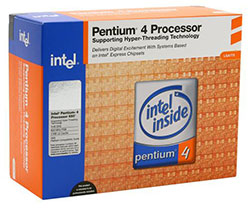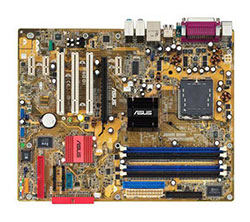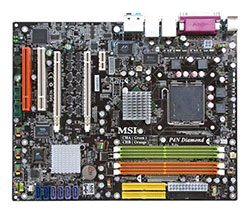Buyer's Guide: Mid-Range to High-End, May 2005
by Jarred Walton on May 23, 2005 5:30 PM EST- Posted in
- Guides
Intel Recommendations
Intel Processors
There are always people who continue to prefer Intel processors for whatever reason. We feel that AMD has the upper hand right now - both in price as well as performance - but there are merits to the Intel platform. We've said it many times before, but let us reiterate that anyone interested in serious 3D gaming should just forget the Intel chips for now. It's really that cut and dry, unfortunately. The dual core Pentium D 8xx parts should also show up at retail any time now, and since multitasking is probably the best argument for Intel enthusiasts, we would seriously recommend waiting for those chips. Those looking to purchase an Intel system now still need to make the decision between 5xx with higher clock speeds and 6xx with more features. (The 5xx chips with EM64T are not yet available either.) In the end, we still can't offer a "one size fits all" choice, so we're declaring it a draw between the two processor lines. You can get a similarly priced 5xx or 6xx chip for both price points, but we're going with 5xx for the Mid-Range and 6xx for the High-End.Intel Mid-Range Recommendation
Processor: Pentium 540J 3.2GHz 1MB (Retail) - Prescott core
Price: $213 Shipped
It's telling that the most reasonably priced CPU from Intel continues to be their 3.2 GHz part. Wasn't the 3.2C originally launched almost two years ago? Anyway, faster Pentium chips are available, but the price scales rapidly. You could even opt for the 3.0 GHz 530J and still get reasonable performance - particularly with overclocking. Although, make sure that you get an appropriate motherboard if you plan on overclocking with an Intel chipset! The 6xx series counterpart to the 540J is the 630, which comes clocked at 3.0 GHz, costs $15 more, and comes with 64-bit support and more cache. If you want to overclock, we'd suggest forgetting 64-bit support and sticking with the 5xx series - doubling the L2 cache does not help with overclocking, needless to say. Still, feel free to try your luck.
Intel High-End Recommendation
Processor: Pentium 650 3.4GHz 2MB (Retail) - Irwindale/Prescott 2M core
Price: $412 Shipped
With the High-End Intel setup, we feel that it only makes sense to grab a 64-bit capable processor. Not everyone is going to need the ability to run XP-64, but if you're going to spend over $400 on a CPU, we think that you're more likely to be part of the bleeding edge who likes to try all the latest and greatest hardware and software. If you disagree or still feel that clock speed is king, the Pentium 560J runs at 3.6 GHz and omits support for EM64T, all while costing $7 (wow!) less. (The 561 should arrive some time in the next couple of months if you're interested in 64-bit support without the 2MB cache.)
The difference between the Mid-Range and High-End Intel processors ends up being just 400 MHz - only 12% to 13% faster in terms of clock speed. Of course, you could also take the CPU recommendation up one more step to the 570J or 660, which would add another $200. (We don't think that it's worth it either.) It's interesting to note that we've had reasonable success running most recent Prescott "J" chips with a 14X multiplier and 1066FSB. All new Pentium 4 processors support EIST, which allows them to reduce the CPU speed and voltages and drop down to 2.8 GHz on an appropriate motherboard. Most enthusiast motherboards allow you to lock the multiplier at 14X and run with the faster bus speed. 3.73GHz ends up outperforming everything including the 570J (due to the increased bus speeds and memory bandwidth, although it's basically a tie) while costing hundreds of dollars less, but nothing is guaranteed with overclocking and some people prefer the guaranteed performance at stock speeds.
Intel Motherboards
The best motherboards for Intel processors pretty much always use Intel chipsets. That may change with the new NVIDIA nForce 4 SLI chipset, but motherboards using the NVIDIA chipset are difficult to find at retail. Furthermore, the new dual core Pentium D processors will require a new chipset to work. That means Intel's 945 and 955 chipsets or the aforementioned nForce 4 SLI for 775. We're still waiting for widespread retail availability (as well as a price drop), which should hopefully come during the next couple of weeks. Newegg and ZipZoomFly (and a few others) have the ASUS P5WD2 (955X) and the MSI P4N Diamond (nF4 SLI), but both cost nearly $250 right now and you still can't find dual core processors. All these factors combined make it difficult to recommend any current socket 775 motherboard, but it's not impossible. There are many good motherboards for both platforms, so just because we don't specifically mention a motherboard, it doesn't mean it's a poor choice. Rather than trying to list the pros and cons of dozens of motherboards, we would suggest that you visit our forums if you want further advice. (Or you can always try emailing us.)Intel Mid-Range Recommendation
Motherboard: ASUS P5GD1
Price: $110 Shipped
There are several things that we're looking for in a decent socket 775 motherboard for a Mid-Range PC. First, we want HD audio and GbE - preferably on the PCIe bus for GbE. We've talked about the difference in price between DDR and DDR2 in the past, but now prices have dropped to the point where that isn't as big of a concern; what's important now is that the board needs to have four memory slots of the same type, since you can't use DDR and DDR2 at the same time. We've never been fans of combo memory designs, as they usually involve a compromise, and that's the case here. Additional features are welcome, but not required, and in the end, we're back to the same ASUS motherboard from our last Mid-Range Guide, albeit with a reduced price. The P5GD1 meets all of the above, and adds in more PATA connectors, good overclocking support, ASUS' proven reliability, and it's still one of the cheaper 775 boards.
The usual suspects are all there with competing products, but they all cost more without offering a whole lot in the way of improved features. The EPoX EP-5EPA+ did well in our roundup, but it's still just a similar product to the ASUS at a higher price. The same goes for the Abit GD8, while the AG8 adds Firewire ports (the only real omission on the ASUS board). The only board that offers something really different from the ASUS is the MSI 915P Neo2 Platinum. It supports DDR2 memory and also has a Firewire connection. Why would you want DDR2 memory? We'll cover this more in the RAM section, but the short answer is that the price/performance for overclocking setups is pretty good.
Intel High-End Recommendation
Motherboard: MSI P4N Diamond
Price: $229 Shipped
Our High-End board is one of the most expensive motherboards that we've ever recommended, and we're giving this recommendation with quite a few caveats. First, we assume that dual core support will work properly (we haven't officially tested it). The bigger factor is that it's one of the few current Intel platform motherboards to support SLI, so if you want Intel and you want the most powerful gaming configuration possible, then you want an nForce 4 SLI board. If you can find a Pentium D to go with this board, our misgivings are not as severe, as certain multitasking tests show that Intel can still beat AMD in that area - particularly when you consider that Pentium D should be available before and cost significantly less than Athlon X2. Just remember that you're spending $70 extra on the motherboard, which certainly cuts into the cost benefits of the platform.
If you want SLI and you don't want to wait for Pentium D to show up at retail, then you're better off with the AMD platform. If you still insist on Intel, that's your right, but most people would say that you're being stubborn. Then again, the cost of a Pentium 4 540J (3.2 GHz) now and a Pentium D 830 (3.0 GHz) later would still be less than the current suggested cost of the cheapest Athlon 64 X2. (My, how the times have changed.) Coupled with the current release schedule - Pentium D should appear at retail several months before Athlon X2 - the High-End, early adopter who demands multitasking performance will probably want to give Intel options some thought. You could always look to SMP workstation setups as well, but then you lose SLI, and that's not something that we want to do for our High-End recommendation.
We should also mention the other SLI option for Intel, the ASUS P5ND2-SLI Deluxe. We've tested that board (along with the P5WD2) and it certainly offers a lot of features. The reason why we didn't recommend it over the MSI board is that it costs an extra $50. Perhaps the MSI board will support DDR2 RAM running at DDR2-1000 speeds and perhaps not. However, most of us don't feel that the additional percentage points gained in performance are worth the increased cost. For gamers, full SLI support is far more important than increased memory speed support.














60 Comments
View All Comments
Calin - Tuesday, May 24, 2005 - link
Oh, and no micro ATX board is the flagship of any mainboard manufacturer. VIA is the only one that has a small mainboard as the flagship (the Mini ITX platform)Calin - Tuesday, May 24, 2005 - link
Hi TujanI think I would like to see more Micro ATX mainboards too. But the idea is that micro ATX boards are not in the segment that typical reviewers like. They usually lack any kind of overclocking potential, their expansion possibilities are very restricted, and in some cases the performance is lacking compared to their big brothers (ATX). Also, they usually have 2 memory slots (unlike 3 to 4 of ATX), and the layout is much more cramped.
Advantages? There could be a price advantage, size and maybe cooling.
JarredWalton - Tuesday, May 24, 2005 - link
crimson117 - Hey, I gave plenty of options for more RAM. The fact is there are very few people that really need more than 1GB of RAM right now. If you need more than 1GB, I'd probably go for 2x1GB rather than 4x512MB, as that gives you the option of upgrading to 4x1GB in the future. Still, 1GB DIMMs are expensive, so 4x512 isn't a terrible choice. Just realize that unless you really need more than 1GB of RAM, you'll end up with slightly slower performance, as none of the boards we've tested will run with 1T command rates and maximum timings when using four DIMMs.crimson117 - Tuesday, May 24, 2005 - link
If you go for the AMD board, I'd recommend getting 4x512mb ram.crimson117 - Tuesday, May 24, 2005 - link
It is a crime to limit such great systems with a mere 2x512mb of ram.KristopherKubicki - Tuesday, May 24, 2005 - link
arswihart: All motherboard manufacturers do that.Kristopher
arswihart - Tuesday, May 24, 2005 - link
that chaintech card is one of the best values in computer hardware, it only has a few downsides, including lack of eq control, no eax (who cares?), can't use microphone input when hi-quality mode (24-bit 96 khz) is enabled, and no spdif in (who needs it?). The Hi-quality 24-bit 96 khz 2-channel mode is what this card is all about, and it is a noticable improvement over onboard audio.Regarding the Catalina card, the sound quality of the DAC's on that card are obviously worse than the Chaintech.
berkut7 - Monday, May 23, 2005 - link
My brother owns the Chaintech soundcard, and the drivers do not have an option that allows control of either treble, or more imortantly (he has the Logitech's Z-560 speakers.) Plus, the soundcard doesn't feature any EAX support, but I don't think EAX even does anything to make games sound better.Tujan - Monday, May 23, 2005 - link
Im a little aprehensive about putting money into Nvidia now.Since there are plenty of other vendors wich have AMD solutions.True Nvidia is the one to best. But it simply cant be an all Nvidia show.Your article is most of dealing with what 'cost is for given components.Think that the smarter buyer is purchasing,especially the first time buyer,based on fact of 'future proofing . In a performance based category. The smarter buyer,is buying performance,they are buying cheaper components on a performance upgrade path.
An example for the AMD setup,a 1.8 Winchester,could be used instead.And too a video card such as an ATI x600pro PCI-e. This shaves about 120.00 off of that notch. A 300+ LCD ? Dont think so. However anyway,the fact is the 'smarter buyer,is taking the cheaper expense,to a platform wich is 'performance.
I know Ive seen the benchmarks for the different Video cards.It isn't a bragging thing to me.My grandma uses DDRMemory on here video card,with a 400Mhz Ramdac,but she uses it on a PCI-e board.
The range of performance/platform is a little different for an Intel platform,where processors run from Celerons ,to EM64 Prescotts.Then stop at where we are now,the 945,955/dual core 'boards.But the range of upgrade is there,and its based on performance.The smarter buyer is taking the least expense,for the platform with the longest upgrade range.
First time buyers are the most luckiest because they do not have to take second chances with their money.
Would like to see more m-atx performance platforms.Motherboards w/o onboard graphics for example.There are only a few.However this would probably be something 'performance should win,over 'cost analysis.
Like IDE,IDE went to IDE33 all the way through to UDMA133. Only criteria was the prerequisite of the 40 pin connector on the motherboard.
Limiting 'range on a 'cost effective analysis is anybodies choice.If there is such a choice.
arswihart - Monday, May 23, 2005 - link
i hope you didn't dump your 8rda+, you should send it to epox I know they will fix your caps or give you a new boardmy caps started bulging as well, without any problems though, but I sent it to Epox anyways and i had another 8rda+ with high-quality caps just over a week after i sent it out. Thats great customer service.